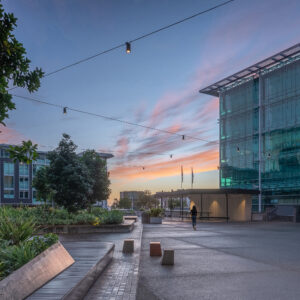
PEDESTRIAN, STREET & AREA LUMINAIRES
Access for all at Riverbend Park
Riverbend Park, Launceston, TAS
- Completed2019
- ClientCity of Launceston
- Sales PartnerSouthern Lighting & Distribution
- Electrical EngineerJMG Engineers and Planners
- Landscape ArchitectPlaystreet
- PhotographerJackie Chan
A dynamic and user-friendly design has transformed a former industrial precinct into a major new recreational area in Launceston, Tasmania.
Funded by the City of Launceston and the State and Federal Governments, Riverbend used the latest in playground and inclusive design and technology to create a destination for local residents and visitors. Riverbend Park, which sits where the Cataract Gorge meets the Tamar River, was once a swampland area used for woolsheds and Boral concreting.
It is now divided into four zones: The River Play area, Gorge Play area, Wild Core area and the Urban Plaza. The spaces revolve around the wild core that offers natural and ‘real’ play areas, with the largest attractions being the Sky Walk and the ‘confluence net’, two of the largest pieces of play equipment in Australia. Particular attention was paid to Indigenous recognition as well as the history of the area being on a floodplain, recognition of natural environment, and the woolsheds history and context.
North Bank Pedestrian Bridge is a separate project that links the park to the city centre. Lighting design for the project was completed by JMG Engineers and Planners, with equipment supplied by WE-EF sales partner Southern Lighting & Distribution. Southern Lighting’s Sales Manager Landon Bannister said the lighting scheme was designed to create a “hierarchy of safe movement”, especially after dark, encompassing a range of use from playground to walkway and then to carpark.
“The main paths are lit to a higher level are lit to a higher level than the subsidiary with the riverbank pathway being kept to a bare minimum for compliance,” Mr Bannister noted.
The primary driver in terms of the lighting design was compliance with relevant AS1158.3 standards, which included P3 for the main pathway, P4 for sub-pathways, P11 and P12 for carparks.
The other design consideration was to be sensitive to the natural environment and the potential impact of light on the night sky and local wildlife, including aquatic ecosystems. The project utilised a wide range of lighting technologies from WE-EF, including its new FLC200-CC projectors, VFL540 and the not-often-seen RMM300 street and area luminaires and, for the first time in Australia, PSY400 bollards.
A highlight of the design are the 12 FLC240-CC 24 LED 84 W projectors with symmetric narrow beam distribution installed on the pedestrian bridge. “This was a council requirement so they could change colours to ‘theme’ different events and times of the year, such as red and green at Christmas, pictured in photographs,” Mr Bannister explained.
The bollard lighting was chosen due to its vandal-proof credentials and the fact that it could keep light spill from the water and minimise light pollution. With four different light distributions to choose from, a large variety of lighting challenges can be addressed and mastered with this luminaire. The PSY400 bollards in 2700 K and 3000 K have been recently certified as ASDA APPROVED luminaires and are recommended for use in the dark sky friendly lighting designs.
The use of the RMM300 for pedestrian pathways was largely an aesthetic choice with its iconic circular design, although superior optics also played a part in the decision.
Aside from raising some poles and changes to the specification of luminaires, the lighting designers did not encounter any major challenges with the project.
“The engineers were happy with the lighting outcomes, and the PSY bollards have been well-received by the council,” Mr Bannister observed. “WE-EF was a natural option because of the waterfront location.” The client was pleased with the effect and appearance of the lighting; the reduction in maintenance and infrastructure costs completed the overall package.

RMM300 street and area luminaires are used to illuminate pedestrian pathways.

The PSY424 bollard was chosen due to its vandal-proof credentials and the fact that it could keep light spill from the water and minimise light pollution.

An FLC240-CC projector installed on the pedestrian bridge.

PSY400 bollards.

